Heron facts for kids
Quick facts for kids Herons |
|
|---|---|
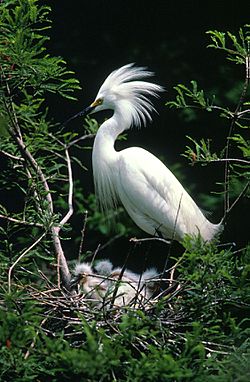 |
|
| Snowy Egret, Egretta thula. Note the chicks in the nest. | |
| Scientific classification | |
| Kingdom: | |
| Phylum: | |
| Class: | |
| Subclass: | |
| Superorder: |
Neoaves
|
| Order: | |
| Family: |
Ardeidae
Leach, 1820
|
Herons are amazing birds that love to wade in water. They belong to a family called Ardeidae. There are 64 different kinds, or species, of herons. Some of these birds are known as egrets or bitterns instead of herons.
All birds in the Botaurus and Ixobrychus groups are called bitterns. They are a special group within the heron family. Egrets are not a separate group in the same way. They are usually called egrets because they are mostly white. They also often have fancy feathers. Egrets look like smaller versions of the larger herons.
Herons look a bit like other birds, such as storks or ibises. But herons fly with their necks pulled back, not stretched out. This is a key way to tell them apart. Herons also have special 'powder down' feathers. These feathers help them keep clean.
Some herons build their nests together in trees. They form large groups called colonies. Other herons, especially bitterns, prefer to nest in areas with tall reeds.
Here are some examples of herons:
Contents
What Do Herons Look Like?
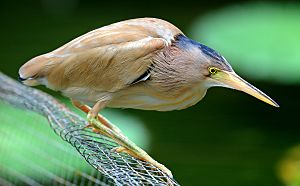
Herons are medium to large birds. They have long legs and long necks. Male and female herons usually look very similar in size. The smallest heron is often thought to be the little bittern. It can be shorter than 30 centimeters (12 inches). Many other small herons are also about this size.
The biggest heron is the goliath heron. It can stand up to 152 centimeters (60 inches) tall. Herons have a special S-shaped bend in their necks. This allows them to pull their necks back. They do this when they fly. Most other long-necked birds fly with their necks stretched out. Herons that hunt during the day have longer necks. Night herons and bitterns have shorter necks.
Their legs are long and strong. They are usually featherless from the lower part of the leg. The zigzag heron is an exception. When herons fly, their legs and feet stick out behind them. Their feet have long, thin toes. Three toes point forward, and one points backward.
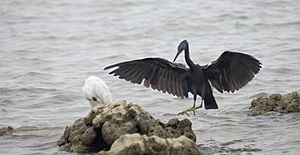
A heron's bill is usually long and sharp, like a spear. It can be very thin, like the agami heron's bill. Or it can be thick, like the grey heron's bill. The boat-billed heron has a very unusual bill. It is wide and thick. The bill and other bare parts of the body are often yellow, black, or brown. These colors can change during the breeding season.
Herons have wide and long wings. They have 10 or 11 large flight feathers. They also have 15 to 20 smaller feathers. Most herons have 12 tail feathers. Bitterns have 10. Heron feathers are soft. Their colors are usually blue, black, brown, grey, or white. Their feather patterns can be very detailed.
Day herons usually look the same, whether they are male or female. But male and female night herons and smaller bitterns often look different. Many herons also have different color forms. For example, the Pacific reef heron can be dark or light. The number of light-colored birds changes depending on where they live. White birds are only found where there are coral beaches.
Where Do Herons Live?
Herons live almost everywhere in the world. You can find them on all continents except Antarctica. They live in most places, but not in the coldest parts of the Arctic. They also avoid very high mountains and the driest deserts.
Almost all herons live near water. They are waterbirds that do not swim much. Instead, they feed along the edges of lakes, rivers, swamps, ponds, and the sea. They mostly live in low-lying areas. But some species can be found in mountain regions. Most herons live in warm, tropical places.
Herons move around a lot. Most species migrate at least part of the year. Some herons only migrate sometimes. For example, the grey heron stays in Britain all year. But in Scandinavia, it usually migrates. After breeding, herons often spread out. They look for new places to find food. This helps reduce pressure on feeding areas near their nests. Herons usually migrate at night. They travel alone or in small groups.
What Do Herons Eat?
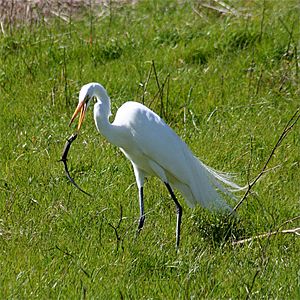
Herons and bitterns are meat-eaters. They mostly live in wetlands and near water. They eat many different live animals that live in water. Their diet includes fish, reptiles, amphibians, crabs, snails, and water insects. Some herons eat many different things. Others specialize in certain foods. For example, the yellow-crowned night heron mainly eats crabs.
Many herons also eat bigger prey when they get the chance. This can include other birds or their eggs. They might also eat small animals like rodents. Sometimes, they even eat dead animals. Very rarely, herons have been seen eating acorns, peas, or grains. But usually, any plant material they eat is by accident.
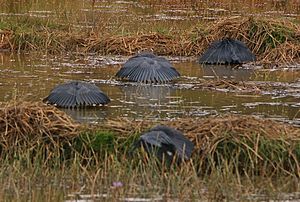
The most common way herons hunt is to sit very still. They wait at the edge of the water or stand in shallow water. They wait until prey comes close enough. Herons might stand tall to see more. Or they might crouch down. This helps them hide. It also puts their bill closer to the prey. Once they see prey, they move their head side to side. This helps them figure out where the prey is in the water. It also helps them adjust for how light bends in water. Then, they use their bill to spear the prey.
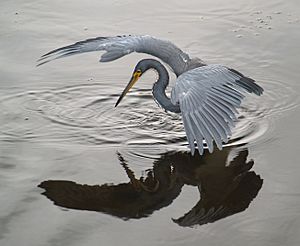
Herons can also hunt more actively. They might walk slowly, taking about 60 steps a minute. They snatch prey as they see it. Other active hunting methods include stirring the water with their feet. They might also poke the ground. This helps to scare out hidden prey. Herons might use their wings to scare prey. Or they might use them to create shade. This can attract prey. The black heron does this best. It forms a full umbrella with its wings over its body.
Some herons, like the little egret and grey heron, have been seen using bait. They use items to trick prey into coming closer. Herons might use things already in the water. Or they might add items to the water to attract fish. For example, striated herons in the Amazon have been seen dropping seeds, insects, flowers, and leaves into the water to catch fish.
Three heron species spend less time near water. These are the black-headed heron, whistling heron, and especially the cattle egret. They can feed far from water. Cattle egrets are very good at finding food by following large grazing animals. They catch insects that the animals stir up. One study showed that cattle egrets caught 3.6 times more prey when they followed animals.
Heron Reproduction
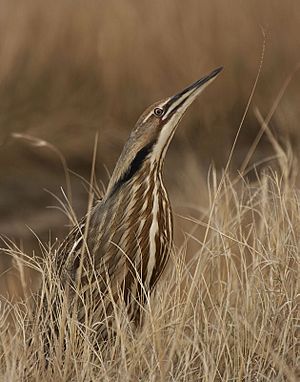
Heron nests are usually found near or above water. They are often built in plants. But some species build nests on the ground if there are no suitable trees or bushes. Many herons use trees. Their nests can be high up. Species that live in reed beds might nest very close to the ground.
Herons usually lay between three and seven eggs. Smaller bitterns and some larger day herons might lay more eggs. Some tiger herons lay only one egg. The number of eggs laid changes with location. Herons in cooler places lay more eggs than those in warmer, tropical areas. Most heron eggs are shiny blue or white. But large bitterns lay olive-brown eggs.
Images for kids
-
Bare-throated tiger heron (Tigrisoma mexicanum)
-
Great bittern (Botaurus stellaris)
-
The Wounded Heron by George Frederic Watts, 1837 (Watts Gallery)
-
Squacco Heron from Egypt
See also
 In Spanish: Ardeidae para niños
In Spanish: Ardeidae para niños










